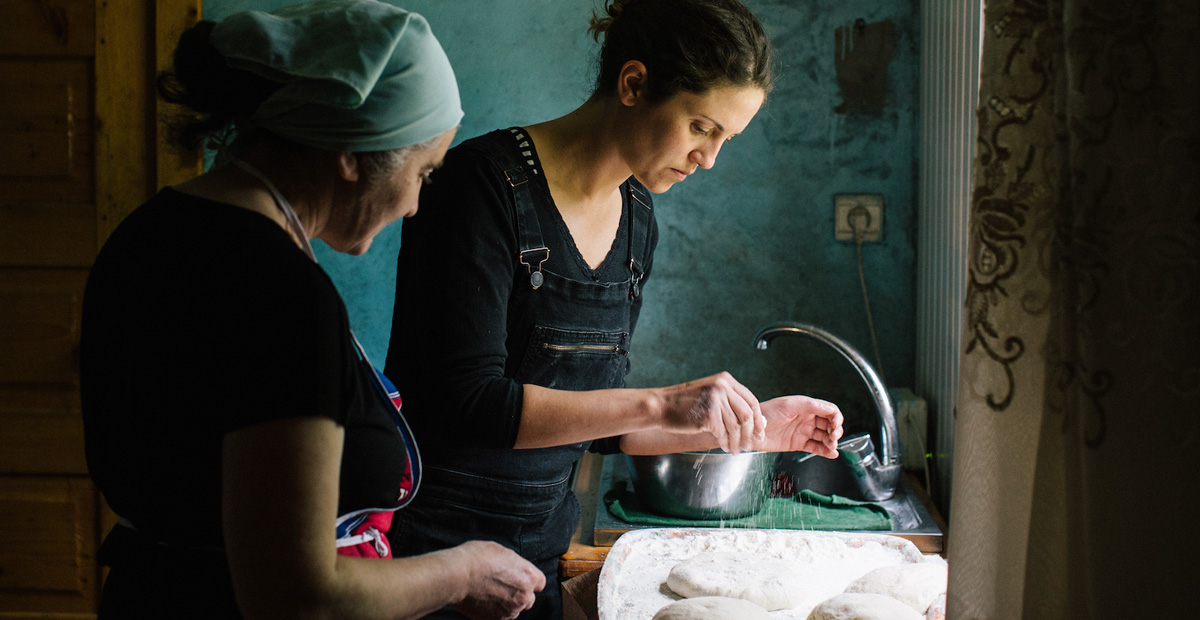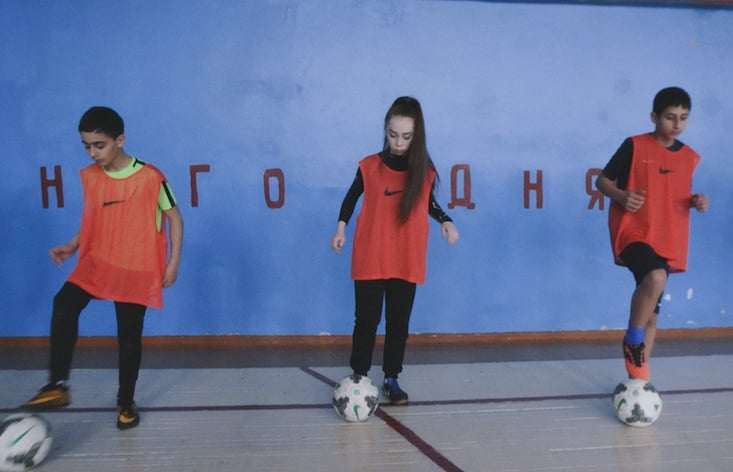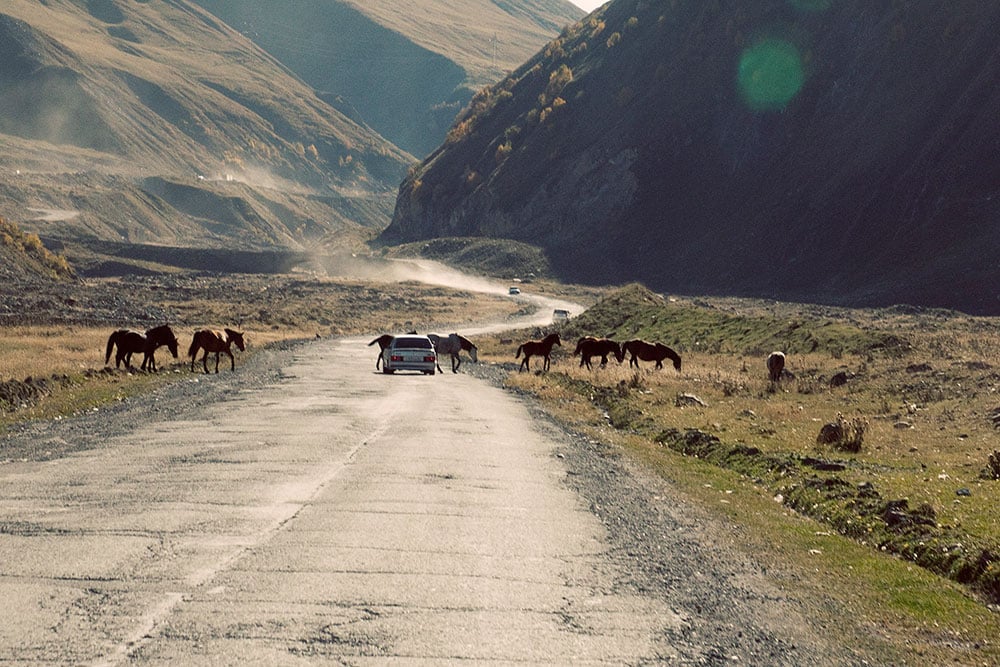Letter from Dargavs: life, death, and quarantine in the Caucasus’ ancient necropolis
Known as the ‘city of the dead’, the necropolis in Dargavs has stood for generations. But as Josh Nadeau discovers, death in the region takes many different forms.
The stone buildings that huddle next to Dargavs are squat and low, with roofs that rise to serrated peaks like pyramids. The whitewashed structures are scattered across a low slope, and walking alongside them I can’t help looking like a misplaced goat. Each building has a small opening close to the ground – it’s only when you bend over to peek inside that you see each one is crammed with human bones.
Located in the Russian republic of North Ossetia, alongside the Georgian border, Dargavs is a village with an official population of just under 200. Its few dozen houses radiate out from the hillside and down the narrow Gizeldon Valley. Cows, horses, and sheep line the riverbank. It’s midsummer now and water levels are low, but it’s not a stretch to imagine this whole valley being carved out by rivers and receding glaciers. The place is remote and wouldn’t draw as many travellers if it weren’t for the necropolis: an ancient cluster of pointed tombs.
Out here, death and remembrance are more a matter of storytelling than statistics
Out here, death and remembrance are more a matter of storytelling than statistics. Only a few legends survive that hint at why the necropolis was built above ground, a relative rarity in the region. Some say a local curse made the earth reject any bodies the villagers tried to bury. Others describe it as a way to save on space in a time when the Alanian Empire, an ancient state from which Ossetians claim their descent, was being pressed on all sides by the Mongols, the Tartars, and the Ottomans.
Respect for bygone ancestors has also been a way to consolidate identity or assert territorial claims. Locals use the crypts as evidence against complaints that these valleys belonged to the neighbouring Ingush people, at least until the Soviet government redrew Russia’s internal borders after the Second World War. It’s harder, the Ossetian argument goes, to be pushed out when you’ve spent centuries stacking your ancestors onto the ground.
All the same, I am told conflicting facts about how old the ancient site, known locally as the “little city of the dead,” really is. The official signs say the buildings date back to the 16th century, but the guards and a nearby shopkeeper insist they could date back as far as the 14th. The republic’s Ministry of Culture, they imply, can’t keep its figures straight.
Necropolis buildings on the slopes of Dargavs. Image: Kabis212/Wikimedia Commons under a CC licence
Yet it’s the ministry that now watches over the bones of the dead. The guards are paid out of the local culture budget to enforce a meagre entry free, as well as to keep away grave robbers looking for souvenirs or memento moris. Tourists, however, arrive sporadically and there are never many at once. Driving here can take more than an hour from nearby Vladikavkaz, depending on conditions, and requires navigating dirt roads over breakneck passes. Which means the guards don’t have a whole lot to do and let me hang around for a while.
Even though there may only be a handful of tourists, in many ways, Dargavs’ history has never felt so relevant. The Gizeldon valley suffered a few rounds of plague in the 18th century (most likely cholera), and so the necropolis buildings doubled as a quarantine site. We don’t know how strictly the quarantine was enforced, but there’s evidence that richer families built their own quarantine pens while the less wealthy made their home alongside the corpses. The sick would take the food relatives or friends handed through the narrow openings and wait until they either got better or added to the crypt’s body count.
It’s hard to imagine the place as a quarantine site. With the coronavirus pandemic still raging in larger cities like Moscow (Russia, at one time this summer, had the second highest number of cases worldwide), Dargavs is probably one of the safest places to be. There are few people, little traffic, and none of the extreme public measures taken in nearby Chechnya and Dagestan, littered with strict checkpoints between counties and semi-legal entry restrictions for people from some of Russia’s larger cities. There are even claims that, particularly in these two Caucasian regions, reporting infections or disclosing accurate death statistics can lead to a brisk chat with local authorities. This is a stark contrast to Dargavs, where drawing attention to the dead is a matter of local pride (as well as much needed tourist revenue).
The Gizeldon Valley suffered a few rounds of plague in the 18th century (most likely cholera), and so the necropolis buildings doubled as a quarantine site
The guards tell me to take my time and I do. There are nearly 100 separate buildings to explore, and inside a few there are open coffins that look like boats. Archeologists say this may indicate an ancient Ossetian belief that getting to the underworld involves crossing a river – whether this was a local superstition or evidence of a pre-Christian belief system we don’t know. There are a few wells you can toss a coin into to see, I’m told, if the souls buried here have made it to heaven or not. The chances are good if the coin makes a sound on its way down.
It’s hard to know which legends and superstitions, many associated with death, are for the tourists and which are legit. Among the gems that don’t hold up under fact-checking is that soldiers in the Alanian army died in battles as far away as Northern Italy (they didn’t), and that the necropolis is UNESCO-recognised (it’s not, although perhaps it should be).
Bones inside the necropolis' buildings. Image: Rartat/Wikimedia Commons under a CC licence
Among the most enduring, however, is the tale that locals avoid the necropolis even today due to the belief that anyone who enters might not come out alive. It is a story that entertains the tourists. But even in a village where livelihoods are built on the shadow of the necropolis that hangs on their doorsteps, when it comes to memories of death, destruction, or displacement, many locals think elsewhere: largely to their southern neighbour, Georgia. North Ossetia has an unrecognised counterpart, South Ossetia, a de facto breakaway territory recognised by most of the world (Russia the most prominent exception) as part of the Georgian state. Border-related armed conflicts between the two peoples have claimed the lives of thousands over the past century, with the most recent having taken place after the collapse of the Soviet Union in the early 1990s. And then again in 2008.
I sit with the guards as the sun goes down (it gets dark quickly in the mountains) as they tell stories about relatives they have on either side of the border. How, in the end, all these conflicts are artificial, and that the different peoples here are brothers. This is particularly true in the case of Georgians, who otherwise share many similarities with the Ossetians. They’re both primarily Orthodox Christians, a rarity among the Muslim-majorty Caucasian republics. St George is evoked liberally by each at festivals and in times of distress. A toast, once raised, should drone on as long as possible, especially over a table laid with Ossetian pies that can easily be mistaken (by outsiders) for Georgia’s trademark dish: khachapuri.
It’s difficult to focus on commonalities once you’ve had to bury your dead
But it’s difficult to focus on commonalities once you’ve had to bury your dead. Blood is thicker than water, and family are more important than what politicians decide in distant capitals. A driver who gave me a lift here earlier said, a little guardedly, that political borders are less important than knowing who your kin are. Each necropolis building, I’m told, belonged to a single family. All the bones have been scattered together and it’s impossible to tell the generations apart, making the crypts a crossroads (a cliche you often hear used about the region) just as much of time as place.
At the store, I meet an Ossetian family who’ve long moved north and are back for a holiday. They’re based in Vladikavkaz but have come out for the day. One of their daughters looks in her mid-teens and plays football in Moscow. She beats the local boys when they team up against her, comes back, flicks through her phone, and asks when they’re leaving.
The Gizeldon valley. Image: Alex Svirkin/Wikimedia Commons under a CC licence
She’s not unlike many youth who have roots in places like these. They push their way out while travellers, like me, push our way in, forgetting not to stare or keep our jaws from drooping as we backpack around. But live here long enough and all these wars, empires, cultures, and crypt-dynasties become mundane, along with the mountains or the tombs themselves.
I haven’t earned the right to be casual about places like Dargavs. The guards shrug when I ask to stay on a while longer and tell me to knock myself out. They leave and tell me to be gone by morning, and not to pilfer anything when I go. Cars drive by slowly and stop to ask if I need water or food; the village’s one store long closed for the night.
People are mostly polite about it, but every now and then the hospitable veneer drops and someone hints that we like places like this because we don’t have to live (or, more to the point, die) here. And as much as I find it depressing, plenty of others don’t mind the village itself dying a slow death. Young people, being young people, leave for places that can actually promise them something more than the past. The past, and our memories of it, is more often than not fodder for passing selfies or the occasional neo-nationalist fantasy. And what else do you do, really, if no one’s making the past as relevant to local youth as it is for travellers like me?
I can’t answer that question. What I do know is that I’m not ready to go just yet.


